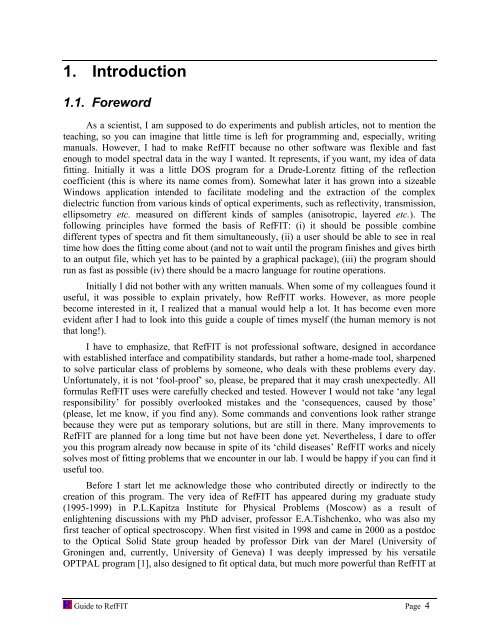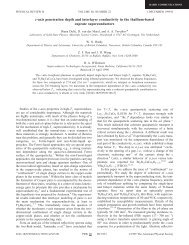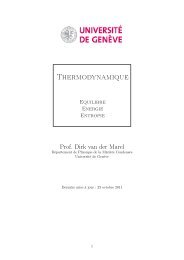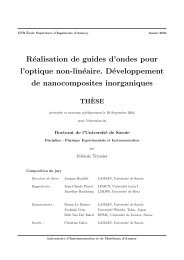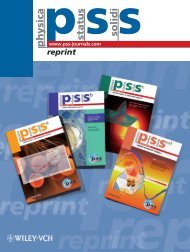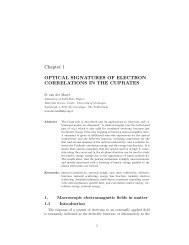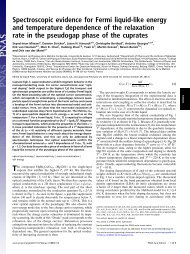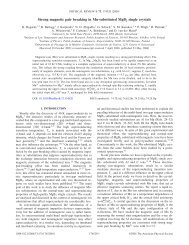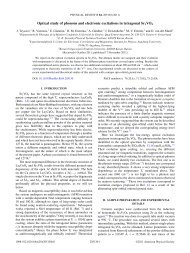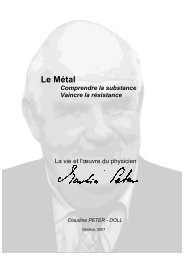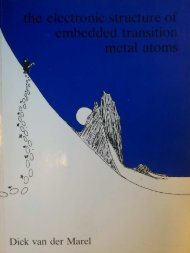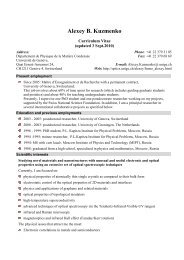software to fit optical spectra - Quantum Materials Group
software to fit optical spectra - Quantum Materials Group
software to fit optical spectra - Quantum Materials Group
Create successful ePaper yourself
Turn your PDF publications into a flip-book with our unique Google optimized e-Paper software.
1. Introduction<br />
1.1. Foreword<br />
As a scientist, I am supposed <strong>to</strong> do experiments and publish articles, not <strong>to</strong> mention the<br />
teaching, so you can imagine that little time is left for programming and, especially, writing<br />
manuals. However, I had <strong>to</strong> make RefFIT because no other <strong>software</strong> was flexible and fast<br />
enough <strong>to</strong> model <strong>spectra</strong>l data in the way I wanted. It represents, if you want, my idea of data<br />
<strong>fit</strong>ting. Initially it was a little DOS program for a Drude-Lorentz <strong>fit</strong>ting of the reflection<br />
coefficient (this is where its name comes from). Somewhat later it has grown in<strong>to</strong> a sizeable<br />
Windows application intended <strong>to</strong> facilitate modeling and the extraction of the complex<br />
dielectric function from various kinds of <strong>optical</strong> experiments, such as reflectivity, transmission,<br />
ellipsometry etc. measured on different kinds of samples (anisotropic, layered etc.). The<br />
following principles have formed the basis of RefFIT: (i) it should be possible combine<br />
different types of <strong>spectra</strong> and <strong>fit</strong> them simultaneously, (ii) a user should be able <strong>to</strong> see in real<br />
time how does the <strong>fit</strong>ting come about (and not <strong>to</strong> wait until the program finishes and gives birth<br />
<strong>to</strong> an output file, which yet has <strong>to</strong> be painted by a graphical package), (iii) the program should<br />
run as fast as possible (iv) there should be a macro language for routine operations.<br />
Initially I did not bother with any written manuals. When some of my colleagues found it<br />
useful, it was possible <strong>to</strong> explain privately, how RefFIT works. However, as more people<br />
become interested in it, I realized that a manual would help a lot. It has become even more<br />
evident after I had <strong>to</strong> look in<strong>to</strong> this guide a couple of times myself (the human memory is not<br />
that long!).<br />
I have <strong>to</strong> emphasize, that RefFIT is not professional <strong>software</strong>, designed in accordance<br />
with established interface and compatibility standards, but rather a home-made <strong>to</strong>ol, sharpened<br />
<strong>to</strong> solve particular class of problems by someone, who deals with these problems every day.<br />
Unfortunately, it is not ‘fool-proof’ so, please, be prepared that it may crash unexpectedly. All<br />
formulas RefFIT uses were carefully checked and tested. However I would not take ‘any legal<br />
responsibility’ for possibly overlooked mistakes and the ‘consequences, caused by those’<br />
(please, let me know, if you find any). Some commands and conventions look rather strange<br />
because they were put as temporary solutions, but are still in there. Many improvements <strong>to</strong><br />
RefFIT are planned for a long time but not have been done yet. Nevertheless, I dare <strong>to</strong> offer<br />
you this program already now because in spite of its ‘child diseases’ RefFIT works and nicely<br />
solves most of <strong>fit</strong>ting problems that we encounter in our lab. I would be happy if you can find it<br />
useful <strong>to</strong>o.<br />
Before I start let me acknowledge those who contributed directly or indirectly <strong>to</strong> the<br />
creation of this program. The very idea of RefFIT has appeared during my graduate study<br />
(1995-1999) in P.L.Kapitza Institute for Physical Problems (Moscow) as a result of<br />
enlightening discussions with my PhD adviser, professor E.A.Tishchenko, who was also my<br />
first teacher of <strong>optical</strong> spectroscopy. When first visited in 1998 and came in 2000 as a postdoc<br />
<strong>to</strong> the Optical Solid State group headed by professor Dirk van der Marel (University of<br />
Groningen and, currently, University of Geneva) I was deeply impressed by his versatile<br />
OPTPAL program [1], also designed <strong>to</strong> <strong>fit</strong> <strong>optical</strong> data, but much more powerful than RefFIT at<br />
Guide <strong>to</strong> RefFIT Page 4


